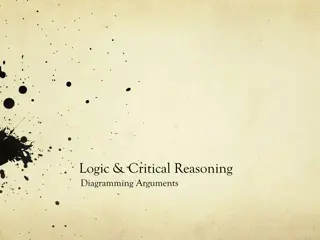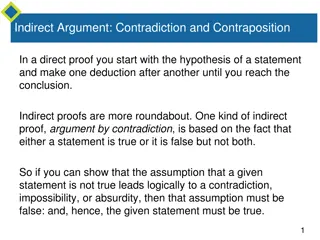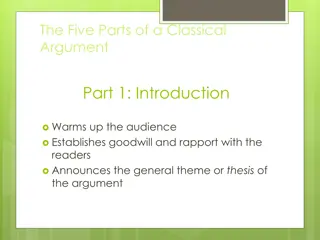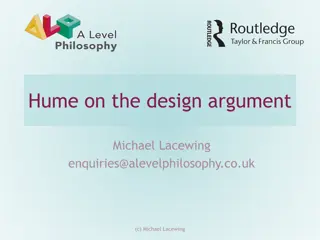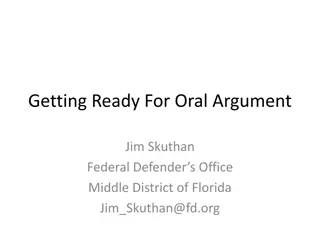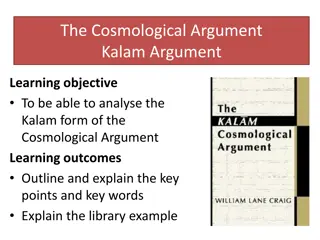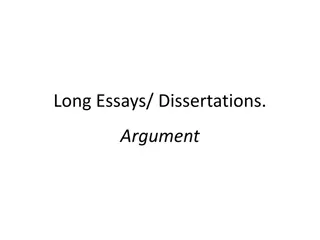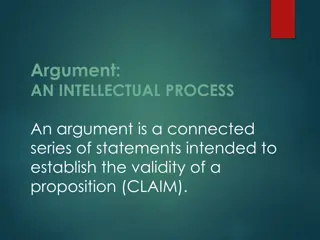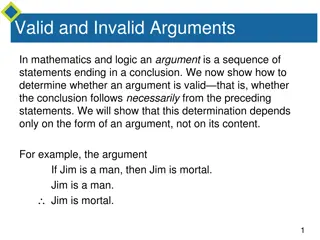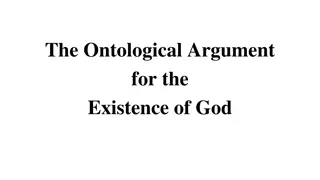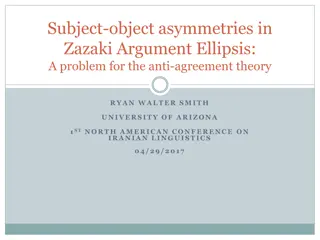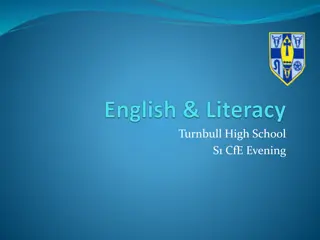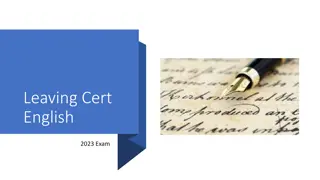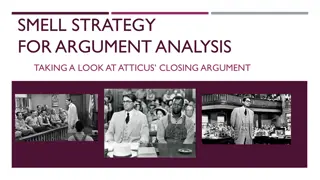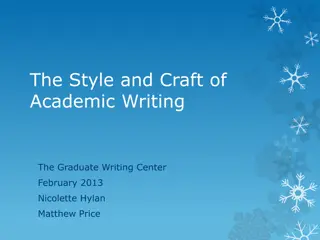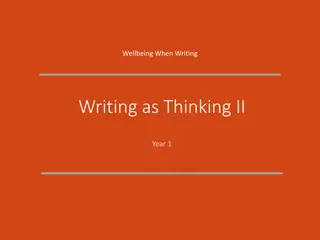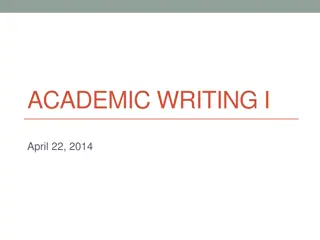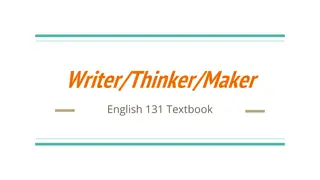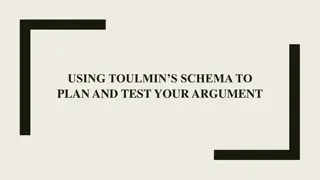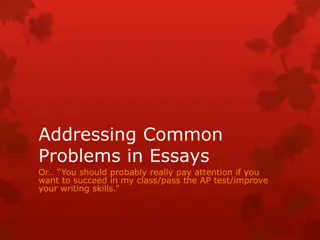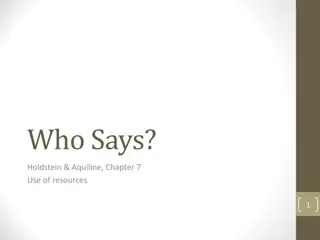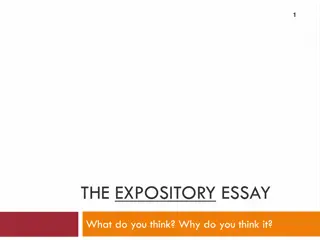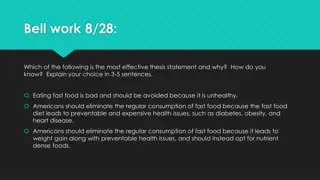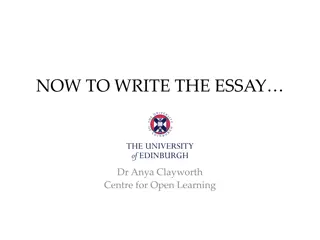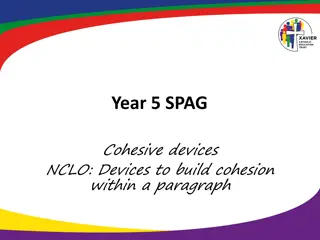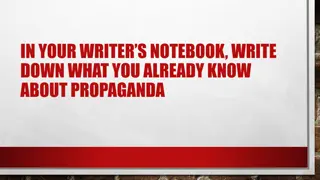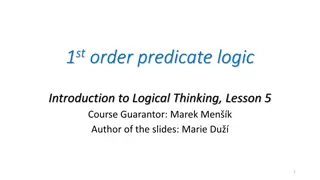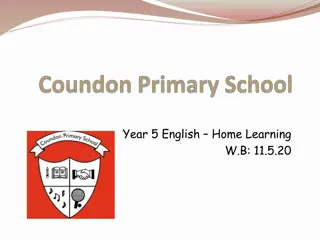Effective Argument Analysis Strategies and Writing Techniques
Explore the key qualities of effective arguments, from sophistication of thought to coherence, and learn strategies to analyze rhetorical situations. Discover various forms of writing, including memoirs, essays, and speeches. Dive into the world of figurative language and word choice, understanding the impact of ethos, logos, and pathos. Enhance your writing skills by employing formal and informal language with appropriate specificity.
- Argument analysis
- Writing techniques
- Rhetorical situation
- Figurative language
- Effective communication
Download Presentation

Please find below an Image/Link to download the presentation.
The content on the website is provided AS IS for your information and personal use only. It may not be sold, licensed, or shared on other websites without obtaining consent from the author. Download presentation by click this link. If you encounter any issues during the download, it is possible that the publisher has removed the file from their server.
E N D
Presentation Transcript
Examining Arguments to Determine Effectiveness
Must have these qualities: Sophistication of thought multiple perspectives (arguments/counter argument) and implication of related events or decisions Sophistication of thought (complexity) looks at Effectiveness argument should include an in-depth analysis of a few sources or pieces of evidence or a broad review of a wide range of sources/evidence Effectiveness (development) the progression of an Unity/coherence based transitions followed by clear topic sentences and sources/evidence that connect (speak to one another) Unity/coherence develop logically using idea-
Begin analysis by describing the rhetorical situation, including: Exigence Audience Writer Purpose Context Message Think, Pair, Share strategies can help you with this step? Think, Pair, Share What active reading strategies can help you with this step? What active reading
Memoirs (snapshot of a moment) Essays Short Stories Speeches Letters Advice Columns Newspaper Editorials Pamphlets Brochures Flyers Notes Interviews Biographies Autobiographies
Writing or speech that is not intended to carry literal meaning and is usually meant to be imaginative and vivid. Often connected to Aristotelian Appeals (ethos, logos, pathos) Think, Pair, Share Think, Pair, Share What is ethos, logos, pathos, How do we demonstrate them in our writing? What is ethos, logos, pathos, kairos How do we demonstrate them in our writing? kairos? ? Commonly Used Examples alliteration, assonance, allusion, hyperbole, imagery, irony, metaphor, personification, simile, hypophora
Refers to the writer s word choices, especially with regard to their correctness, clearness, or effectiveness Formal polysyllabic, elegant (scholarly, pedantic, precise, pretentious) Appropriateness Appropriateness Neutral standard language, not elaborate (plain, simple) Informal common, conversational (idioms, colloquialisms, jargon, colorful) Concrete - specific words attract our senses (flowers) Specificity to uniquely individual persons, events, or objects Specificity - refers Abstract - specific words relate to concepts that are mostly inferred (love)
The way an author chooses to join words into phrases, clauses, and sentences. Similar to diction, but refers to groups of words groups Appositive - restates a preceding term (Her dog, a bull mastiff) of words, rather than individual words. Gerund - includes a verbal, a hybrid that functions as a noun or adjective (Juggling knives is not recommended) Clause Clause a subject and a verb (Vlad slept in a coffin) Infinitive - includes the word to and a verb as the basis of a root sentence (His effort to pass the bill) Phrases Phrases - any group of words carrying a special meaning Participial - verbals ending in -ing or ed (or another irregular form of a verb) serving as an adjective (Having been lied to before, I was wary) Prepositional - a preposition and a noun or pronoun that serves as the preposition s object (I went for a walk in the dark woods)
Length Short Slows reader, draws emphasis Long Quickly moves reader Ask why author made specific length choices! Punctuation Authors add or neglect punctuation to create a desired effect Watch for punctuation other than a period or a comma How is that effect different than if the author wrote everything out explicitly? Learn to think of it as a deliberate choice meant to convey a point you should notice! First Word and Last of a Sentence The most quoted lines of books are the first or the last. Sentences act in a similar manner. They tell us what s important, establish themes, guide us in the direction the author intends. Look for patterns and repetition of words or phrases! Go beyond just stating a repetition - to analyze why it is used and what point it conveys in the larger context of the piece!!!
Patterns A break in pattern is especially used for adding emphasis in a passage. Look at the break in pattern as intentional and examine what the author is trying to guide you to as the reader! Purpose A declarative makes a statement (You ran a mile). An interrogative forms a question (Did you run a mile?) An imperative gives a command (Run a mile). An exclamatory expresses a strong feeling (You ran a mile!). Stating that this sentence is declarative or this sentence is exclamatory is not enough explain the intended effect!
What is the writers thesis (main claim to be defended or proven through reasoning supported by evidence)? Is the thesis explicit or implicit? Think, Pair, Share What is the claim in Minnow Pea Is it explicit or implicit? Think, Pair, Share What is the claim in Ella Minnow Pea? ? Is it explicit or implicit? Ella How does the thesis wording reflect the rhetorical situation and scope of the argument? How does the thesis reflect the author s position on the subject? Where in the argument does the writer present the thesis? Why did s/he choose this placement? How does the thesis preview the author s line of reasoning?
Evidence facts, anecdotes, analogies, statistics, examples, details, illustrations, expert opinions, personal observations, personal experiences, testimony, experiments Evidence - What is the evidence s function (clarify, set a mood, give an example, associate, amplify, qualify a point)? How does the choice of evidence reflect the rhetorical situation and advance the purpose? How does the writer s commentary establish a logical relationship between the evidence and claim? Think, Pair, Share Pea Think, Pair, Share Name a piece of evidence in Pea? What type is it? How does it reflect the rhetorical Name a piece of evidence in Ella Minnow ? What type is it? How does it reflect the rhetorical Ella Minnow situation? situation?
Thinking about something in a logical way. Developing a sensible analysis, conclusion or implication of a situation (War will lead to destruction). Line of Reasoning line, or thread, throughout the work that brings it all together logically based on the reasoning (or evidence and analysis) the author uses. Line of Reasoning - a distinct Deductive rests on a fundamental truth or value, known as the premise; top down logic Deductive - argument that Inductive - draws a conclusion based on specific evidence Inductive Analyzing the line of reasoning is analyzing if all aspects of the article lineup with the claim, or thesis statement, of the article.
Ella Minnow Pea Claim: Loss of freedom leads to deterioration of a society Line of Reasoning (inductive, causal) Censorship causes conflict among residents Conflict causes government intervention that impacts businesses, education, daily life Government intervention causes an abuse of power Abuse of power results in citizens fleeing or being banished, leading to a deteriorated (almost non- functional) society
Common approaches writers frequently use to develop and organize the reasoning of their arguments. Narration reflections and insights on the significance of those experiences Narration - offers details about real-life experiences, as well as Cause consequences of that cause Cause- -effect effect - presents a cause and asserts effects or Provides an audience with the means to trace a writer s reasoning in an argument Comparison then examines the similarities and/or differences between the objects (like categories of comparison must be used) Comparison- -contrast contrast - presents a category of comparison and Definition or description or sensory details of an object or idea Definition or description - relates the characteristics, features,
Shows the relationship between ideas using figurative language, diction and syntax The arrangement of ideas to develop a coherent argument Look for repetition, synonyms, pronoun references, or parallel structure, and transitional elements!
Mark Dunn develops a sophisticated, effective and coherent argument on the dangers of oppression in the epistolary novel Ella Minnow Pea. Using a zealous and sometimes juvenile tone, Dunn employs inductive, causal reasoning supported by Aristotelian Appeals, figurative language, colorful diction and varied syntax to persuade young Americans in a post-9/11 culture.


